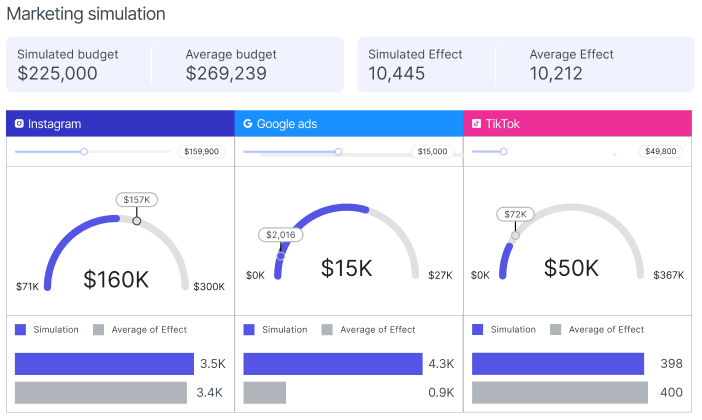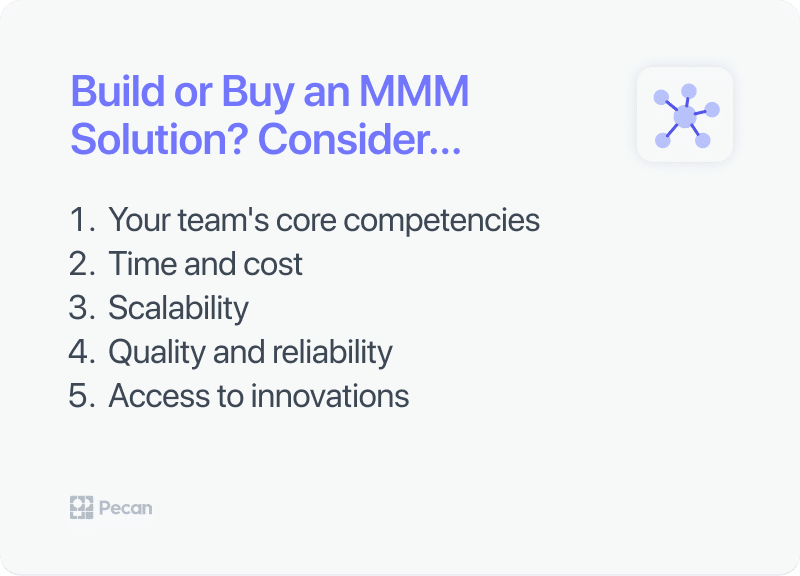In a nutshell:
- Marketing mix modeling (MMM) is a technique that measures the impact of different marketing channels on sales or other key performance indicators.
- Traditional MMM methods are slow and time-consuming, but machine learning can speed up the process by automating tasks and analyzing large amounts of data.
- Machine learning-powered MMM lets businesses quickly identify trends and insights to improve marketing strategies.
- Today's MMM also allows for creating "what-if" scenarios to help plan future budgets.
- When implementing MMM, companies should consider providers' core competencies, time and cost, scalability, quality and reliability, and innovation.
Marketers face uncertainty as the digital ecosystem shifts to new privacy standards and cookieless attribution.
A recent report shows that roughly 50% of CMOs still need to prepare for this change. Marketing mix modeling (MMM) is re-emerging as an essential measurement approach for marketing leaders. The traditional methods of implementing MMM need to adapt to the current needs of modern marketers.
This issue was highlighted in a Pecan webinar: a concern that the traditionally slow-moving nature of MMM prevents it from being refreshed frequently. But that’s not the case today.
In fact, MMM has improved so much with today's machine learning techniques that in a Harvard Business Review article, experts noted that MMM could be considered the "new gold standard for digital ad measurement."
Let’s dive into marketing mix modeling and machine learning and explore how machine learning speeds up today’s MMM process. We will also explore the pros and cons of using an ML-based MMM solution and provide tips for implementing it.
Understanding the Basics of Marketing Mix Modeling
We talk about marketing mix modeling (MMM) in great detail in another recent blog post. Our CEO and co-founder, Zohar Bronfman, dove into the history of MMM at Forbes, too.
But for a high-level overview, marketing mix modeling algorithms measure the impact of different media channels on sales or other key performance indicators (the dependent variable). It considers various factors, such as marketing spend, pricing, distribution, and external factors, like seasonality, to identify effective marketing strategies.
Studies show that companies that use MMM see around a 10% increase in ROI. Integrating online and offline campaign data in MMM involves combining data from various sources to view marketing performance comprehensively. This approach helps marketers understand the relative impact of each channel and optimize their marketing mix accordingly.
Research suggests that integrating online and offline data can increase the accuracy of MMM by up to 20%. By incorporating data from both online and offline channels, MMM provides a holistic view of the ROI of marketing inputs, leading to better decision-making and optimization of marketing spend.
Overall, the process of marketing mix modeling helps businesses gain a better understanding of their customers and their preferences. This approach guides more effective marketing strategies and media planning tailored to their target audience and business outcomes.
Additionally, it helps businesses identify areas of improvement and optimize their marketing investments for maximum efficiency and effectiveness.
Understanding the Basics of Machine Learning
At its core, machine learning is a type of artificial intelligence (AI) that enables computers to identify patterns in data using statistical methods. It gathers information from datasets, learns from past experiences and observations, and then uses this knowledge to generate insights and make decisions.
Machine learning algorithms are used to identify patterns in data and make predictions. These algorithms can detect anomalies in data, classify data, and make predictions about future events.
By leveraging the power of machine learning, businesses can gain valuable insights and make better decisions.
Where Does Old-Fashioned MMM Fail?
Older marketing mix modeling approaches often took months, if not quarters, to complete because they required large amounts of data and complex statistical analysis.
This difficulty level and pace are why this older method was adopted only by large, well-resourced companies that could handle this complex process. Older forms of MMM traditionally took more time due to three reasons:
- To conduct a thorough analysis, the model must incorporate variables such as sales data, marketing spending, pricing, distribution, and external factors such as economic trends or seasonality. Gathering this data from multiple sources and cleaning and formatting it (without the help of machine-learning tools) can take significant time and resources.
- Once the data is collected and cleaned, it must be processed and analyzed using advanced statistical techniques. This step involves building and validating multiple models, testing different assumptions, and evaluating the model’s accuracy and effectiveness. The process can be iterative, with numerous rounds of model refinement and validation, further extending the timeline. Again, this can be very time-consuming and expensive without using ML-based methods to expedite the process.
- Additionally, traditional marketing mix modeling approaches require quite a bit of statistics and data analysis expertise. Finding the right experts to handle this older method could be challenging.
Overall, the complexity of the data, the analysis techniques, and the need for specialized expertise make “old-fashioned” marketing mix modeling a time-consuming, expensive, and slow process.
However, advances in AI and data analytics are leading to faster and more efficient modeling techniques, such as machine learning, that make this method much more accessible for all marketing teams.
The Benefits of Machine Learning for Marketing Mix Modeling
The primary benefit of using machine learning for marketing mix modeling is that it enables businesses to analyze vast amounts of data much faster than traditional methods.
MMM can help enterprises quickly and accurately identify new trends and insights to improve their marketing strategies. Additionally, machine learning reduces the number of manual processes required, making the process smoother and more efficient.
Creating an MMM-based “what-if” scenario tool is a second and lesser-known benefit. With the power of machine learning, brands can now model their marketing mix and create what-if scenarios to help them plan out the next budget. With ML-based scenario tools based in MMM, brands can:
- Easily simulate different budget allocations
- Immediately see the predicted outcomes
- Strategically decide on the most profitable budget allocation
Pecan's MMM simulation tools help you explore what-if scenarios with your marketing spend.
How Machine Learning Speeds Up Marketing Mix Modeling
Machine learning can speed up the process of marketing mix modeling by automating many tasks and using advanced algorithms to analyze large amounts of data.
First, machine learning can automate data processing tasks such as cleaning, formatting, and integrating data from multiple sources. Automated data preparation can save significant time and improve accuracy compared to manual data preparation. Powerful cloud computing makes this process even faster.
Second, machine learning algorithms can identify patterns and relationships within the data that may not be apparent to human analysts. These algorithms detect complex interactions between variables, such as weather's impact on sales or seasonality's effect on advertising effectiveness. Machine learning can save time and provide more accurate insights by automating this process.
Third, machine learning can enable faster model building and testing. Traditional marketing mix modeling often involves building multiple models and testing different assumptions, which can be time-consuming.
With machine learning, models can be built and tested more quickly using advanced algorithms that can rapidly evaluate different combinations of variables. It's also much easier to refresh models with current data.
What's the difference between MMM and MTA?
Marketing Mix Modeling (MMM) and Multi-Touch Attribution (MTA) are two popular approaches used in marketing analytics to measure the effectiveness of marketing campaigns. Both can use machine learning, but they serve different purposes for marketers.
MMM is a modeling technique that analyzes historical data to understand the impact of online and offline media activities on sales or other metrics. It considers factors such as pricing, promotions, advertising, and distribution channels to determine each element's contribution to a campaign's overall success.
But if you want to dig into how to attribute conversions or sales to specific marketing touchpoints — that's where MTA comes in. It uses ML algorithms to analyze customer interactions with different marketing channels and assigns credit to each touchpoint based on its influence on the outcome.
MTA provides a more granular view of marketing effectiveness that can be especially useful for campaign optimization. While MMM provides a holistic view of marketing effectiveness, MTA offers a more detailed understanding of the customer journey and the impact of individual touchpoints.
MMM is typically used for long-term strategic planning and budget allocation, while MTA is more suitable for tactical optimization and campaign management. Both approaches have their strengths and limitations.
And in fact, you can use MTA and MMM together for a complete picture of your marketing performance.
Tips for Selecting a Marketing Mix Modeling Process
When considering implementing MMM, a fundamental “Build vs. Buy” question must be addressed. Generally speaking, several variables need to be considered to ensure a successful implementation of a working ML model.
Some of the most important topics to consider when evaluating an in-house team or outsourcing the work to a third party are:
- Core competencies: Is data science a core competency of your business? Machine learning requires extensive expertise in statistics, data analysis, and programming. Working with a predictive analytics platform from a SaaS company can provide access to a team of experts with specialized knowledge and experience in building and deploying ML models for better model quality and faster time-to-market.
- Time and cost: Building an in-house team to develop and deploy ML models can be time-consuming and expensive. Purchasing a solution can be more cost-effective by leveraging existing infrastructure, tools, and expertise.
- Scalability: Machine learning models often require significant computational resources and specialized hardware, which can be expensive to acquire and maintain in-house. A SaaS MMM solution can be scalable and quickly adapt to changing business needs and evolving technologies.
- Quality and reliability: Deploying ML models requires rigorous testing and validation to ensure model accuracy and data security. Working with an ML SaaS company can provide access to advanced testing and validation tools and processes that can improve the quality and reliability of the models.
- Innovation: ML platform developers are often at the forefront of new technologies and techniques. Working with these companies can provide access to the latest innovations and best practices in ML model development and deployment.
Working with a SaaS provider for an ML-based MMM solution can provide significant advantages in expertise, time and cost savings, scalability, quality and reliability, and innovation.
Marketing departments should consider their needs and resources carefully when deciding whether to build ML models in-house or work with a specialized deployment company.
Examples of using MMM for marketing efficiency
U.S. giant uses MMM to identify millions in potential savings
A company with a substantial media budget exceeding $1 billion faced the challenge of optimizing its marketing spending to improve operating margins and efficiency during an economic slowdown. With approximately 30% of their budget allocated to linear TV and radio advertising and limited digital marketing data, they needed a solution to make data-driven decisions.
They turned to Pecan's marketing mix modeling (MMM) to predict customer inquiries based on budget allocation. The MMM model analyzed years of data on marketing spending, channels, and states to provide accurate predictions for the next 12 months. Additionally, MMM allowed for simulations of different budget allocations, helping marketers identify the best strategies to maximize inquiries.
The results showed that with MMM's insights, the company could increase customer inquiries and save over $100 million annually through optimized allocation adjustments. The story highlights the potential for further refinement and expansion of the MMM model to maximize marketing spend based on customer lifetime value and cost per acquisition, demonstrating how data-driven planning can make a significant business impact in challenging market conditions.
App developer uses MMM to cut acquisition costs by 10%
A prominent app developer specializing in image enhancement apps faced challenges in assessing the impact of their marketing strategies due to the shifting data landscape of mobile privacy standards, particularly Apple's SKAdNetwork. With a substantial user base primarily consisting of U.S. iOS users, they lost valuable insights into their user base following the iOS 14.5 update.
To swiftly adapt to this changing mobile ecosystem, the company's user acquisition team collaborated with Pecan to implement a Marketing Mix Modeling (MMM) solution. Within three weeks, Pecan's MMM offered in-depth budget insights and simulation tools that enabled the team to reduce the customer acquisition cost (CAC) for their most popular app by 10% in the United States, a region responsible for 45% of their new user acquisitions.
This powerful tool gave the UA team fresh insights into cost per acquisition and channel effectiveness, allowing them to make more informed cross-channel budget decisions and optimize successful marketing strategies in a rapidly evolving mobile app environment.
Ready to get started?
If you’d like to learn more about marketing mix modeling and how to get started with this powerful approach in your business, we’ve got some great resources for you!
Check out our on-demand webinar featuring Pecan’s MMM experts, download our in-depth guide to MMM, or get a broader perspective on how ML-based methods can support you as a marketing leader in planning marketing strategies in The CMO’s Guide to Predictive Analytics.
Put machine learning and marketing mix modeling to work today. Contact us to set up a time to chat about Pecan and your marketing team’s needs.






